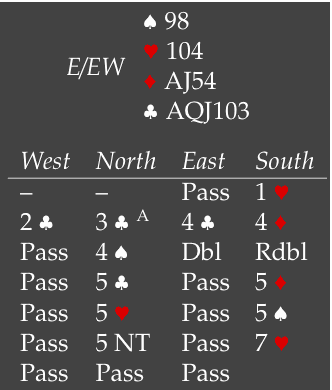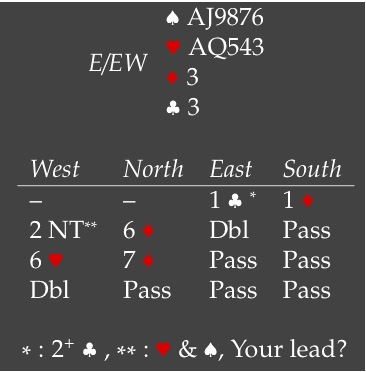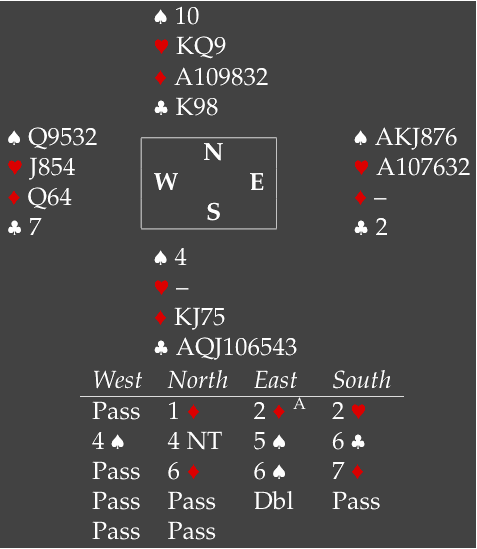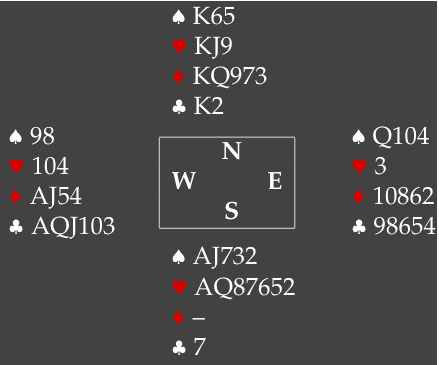 It has been a while since this blog was last updated. What can I say, the best summary is probably that life interfered with playing and blogging. Sorry to those who have been missing the regular updates to the blog.
It has been a while since this blog was last updated. What can I say, the best summary is probably that life interfered with playing and blogging. Sorry to those who have been missing the regular updates to the blog.
 The easiest contract to defeat a grand slam is to cash your ace. But what if you have 2 aces? This hand came up in the finals of the US Grand National Teams, one of the open team championships over there. The event was obviously broadcasted on BBO. Teams, the final board of the match. You obviously don’t know the exact score, but you know that it is a very close match and that this hand can make the difference. 3♣ showed a heart raise, limit or better. Cuebids followed and all you have to do is to cash the right ace.
The easiest contract to defeat a grand slam is to cash your ace. But what if you have 2 aces? This hand came up in the finals of the US Grand National Teams, one of the open team championships over there. The event was obviously broadcasted on BBO. Teams, the final board of the match. You obviously don’t know the exact score, but you know that it is a very close match and that this hand can make the difference. 3♣ showed a heart raise, limit or better. Cuebids followed and all you have to do is to cash the right ace.
 While considering your lead, it might help to think back about similar hands in history. Earlier this year, I reported on this hand. Again, you are on lead against a grand holding 2 aces. If you don’t recall the hand, here is the solution to that problem.
While considering your lead, it might help to think back about similar hands in history. Earlier this year, I reported on this hand. Again, you are on lead against a grand holding 2 aces. If you don’t recall the hand, here is the solution to that problem.
 And most students of the game will be familiar with this hand from the 1980 Olympiad. 2 aces and a doubled grand, your lead. At the table, Hamman decided that the opponents were more likely to have a spade void rather than a heart void, and let the ♥A. Wrong, declarer assumed that the diamond length was on his left and wrapped up 13 tricks for a 19 imp gain against 6♠x, down 1 in the other table.
And most students of the game will be familiar with this hand from the 1980 Olympiad. 2 aces and a doubled grand, your lead. At the table, Hamman decided that the opponents were more likely to have a spade void rather than a heart void, and let the ♥A. Wrong, declarer assumed that the diamond length was on his left and wrapped up 13 tricks for a 19 imp gain against 6♠x, down 1 in the other table.
Back to the more recent problem. What do we know about the hand. South has cuebid diamonds twice, so he must be void there. North could have bid 4♣, rather than 3♣, as a splinter raise with short clubs. He didn’t, so he is likely to have a few clubs himself. NS are good players, so it is unlikely that they’ll bid a grand with a club loser. How can NS avoid the club loser? With a second void in south. 2 voids in the minors imply something like a 6-7-0-0 or 5-8-0-0 shape with south.
However, making a grand is not only about avoiding losers, one also somehow has to set up 13 tricks. Here that means setting up the spade suit. To do so, may require a ruff. To avoid that from happening, the best defense is to lead a trump.
 So, with all this in mind, west led a trump. Well reasoned, but horribly wrong if you look at all 4 hands. And it was indeed an important board. West’s team was leading by 4 imps before this board but lost 11, and the match, on this board when the other table bid only 6♥.
So, with all this in mind, west led a trump. Well reasoned, but horribly wrong if you look at all 4 hands. And it was indeed an important board. West’s team was leading by 4 imps before this board but lost 11, and the match, on this board when the other table bid only 6♥.
Did you notice a trend in these hands? In all cases, you should have led the ace in your longest suit. At first, this looks strange. After all, the more cards you have, the higher the probability that one of the opponents has a void. However, when a player holds a few small cards, in a suit that is bid and raised by the opponents, he is going to assume that his partner will be short. How short? That will be hard to judge, occasionally the opponents have less trumps than you’d expect and there often isn’t enough bidding space to find out exactly. That increases the chance that the opponents bid a grand with a singleton opposite a few small. So, the next time you’ll find yourself on lead against a grand holding 2 aces, you know what to do.
